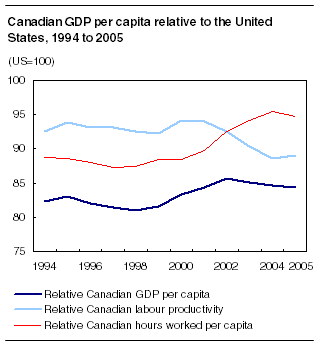Common menu bar links
Study: GDP per capita and productivity in Canada and the United States
Archived Content
Information identified as archived is provided for reference, research or recordkeeping purposes. It is not subject to the Government of Canada Web Standards and has not been altered or updated since it was archived. Please "contact us" to request a format other than those available.

Canada's economic output per person is lower than it is in the United States, but the gap has narrowed since the turn of the millennium, according to a new study.
Canada's gross domestic product (GDP) per capita stood at 84.3% of GDP per capita in the United States in 2005, an improvement from the low of 81.0% in 1998. This was also slightly above the average of 83.2% for the 12-year period between 1994 and 2005.
The gap in GDP per capita between Canada and the United States is driven by two factors. These are the differences in labour productivity, which are measured as GDP per hour worked, and the differences in the number of hours worked per capita between the two countries.

The relative importance of these factors has been changing over time. Prior to 2000, both components were relatively constant. However, since 2000, relative productivity in Canada has declined, while relative hours worked per capita variable has gone up dramatically.
The study found that in the 1990s, over two-thirds of the gap in GDP per capita between the two countries was due to differences in hours worked per capita and about one-third due to differences in labour productivity. By 2005, on the contrary, differences in labour productivity between the two countries accounted for two-thirds of this gap.
Note to readersThis study is the third in a series on the project initiated in the fall of 2003 by the Canadian Productivity Accounts at Statistics Canada to compare the level of productivity between Canada and the United States. In this study, the output gap between the two countries is measured using relative nominal gross domestic product (GDP) per capita, which is expressed in a common currency, using purchasing power parity indices. Relative GDP per capita may be broken down into three components: relative labour productivity, that is, GDP per hour worked; effort (relative hours worked per job) and the relative employment rate per capita (ratio of number of jobs to total population). This study describes the methods used to estimate each of these factors. A large part of this study is devoted to developing and illustrating the conceptual and methodological framework required to make Canada-United States estimates of labour and population comparable in terms of levels. It also attempts to quantify the "statistical error" that arises from using inadequate statistics, or statistics not designed for this type of international comparison. To obtain the dataset containing the GDP, hours worked and population estimates used in this study, send an email to (productivity.measures@statcan.gc.ca). |
Since 2000, hours worked per capita in Canada have improved because the Canadian economy has been generating new jobs at a much faster rate than the American economy. This has led to the recent improvements in Canada's relative GDP per capita.
Large gains in Canada's hours worked per capita relative to the United States
Starting in 2001, Canada has experienced large gains in hours worked per capita relative to the United States. From the mid- to late-1990s, the number of hours worked per capita in Canada represented only about 88% of the level in the United States.
However, since 2000, this proportion has increased sharply. By 2005, the number of hours worked per capita in Canada reached 94.7% of the US level.
These recent increases in the relative number of hours worked per capita in Canada have been driven by stronger job growth in Canada than in the United States. These strong gains have narrowed the gap between Canada and the United States in terms of the ratio of jobs to the working age population.
In 1999, the ratio of jobs to the population aged 15 years and over in Canada was 90.6% of that in the United States. Since 2003, this ratio has stabilized around 97%.
Decline in relative labour productivity partially offsets gain in relative hours worked per capita
Recent gains in the relative number of hours worked per capita in Canada have been partially offset by reductions in Canada's relative labour productivity.
Labour productivity is measured as the nominal GDP per hour worked for the overall economy.
In 2000, productivity in Canada was 94.1% of that in the United States. By 2005, this proportion had declined to 89.0%. In recent years, the Canadian economy has experienced several shocks, including the severe acute respiratory syndrome crisis, the outbreak of bovine spongiform encephalopathy, the power blackout in Ontario, and the sharp appreciation of the Canadian dollar.
From 1994 to 2005, Canada's annual labour productivity was, on average, 92.2% of labour productivity in the United States.
The research paper "The comparative level of GDP per capita in Canada and the United States: A decomposition into labour productivity and work intensity differences" (15-206-XWE2007008, free) is now available as part of The Canadian Productivity Review series from the Publications module of our website.
More studies related to productivity are available free of charge at (/studies-etudes/econo-eng.htm).
For more information, or to enquire about the concepts, methods or data quality of this release, contact Jean-Pierre Maynard (613-951-3654), Income and Expenditures Accounts Division.


 Table(s).
Table(s).